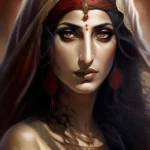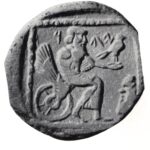The Manticore is a fascinating creature from Middle Eastern mythology. Known for its fearsome appearance and deadly nature, the Manticore has captivated the imaginations of many throughout history. This mythical beast is often depicted with the body of a lion, the wings of a dragon, and the tail of a scorpion, which adds to its fearsome reputation. The origins of the Manticore can be traced back to ancient Persia, where it was first mentioned in texts and folklore. Over time, its legend spread across various cultures, leading to different interpretations and representations of this intriguing creature.
Origins of the Manticore
The origins of the Manticore can be traced back to ancient Persian mythology. The name “Manticore” is derived from the Persian word “martikhoras,” which translates to “man-eater.” This name reflects the creature’s reputation as a fierce predator that hunted and consumed humans. The Manticore is believed to have been inspired by real animals, such as lions and tigers, combined with elements from other mythical beings. The combination of these features creates a creature that is both majestic and terrifying.
 Lilith
LilithIn ancient Persian texts, the Manticore was often depicted as a guardian of the underworld or a symbol of destruction. Its role in these stories varied, but it was consistently portrayed as a creature to be feared. As the tales of the Manticore spread to neighboring cultures, its image evolved. The Greeks, for example, incorporated the Manticore into their own mythology, often portraying it as a monstrous beast that would challenge heroes on their quests.
Physical Description
The physical description of the Manticore is one of its most striking features. Typically, it is depicted as having the body of a lion, which symbolizes strength and power. The lion’s body represents the Manticore’s predatory nature and its role as a fearsome hunter. In addition to its lion-like body, the Manticore is often shown with the wings of a dragon, giving it the ability to soar through the skies. This aspect of its design adds an element of mystery and danger, as it can attack from above.
The tail of the Manticore is perhaps its most distinctive feature. It is commonly represented as a scorpion’s tail, capable of delivering a venomous sting. This tail not only enhances the creature’s lethal nature but also serves as a reminder of its connection to the darker aspects of mythology. The Manticore’s face is often depicted as resembling that of a human, with sharp teeth and a fierce expression. This combination of animalistic and human traits makes the Manticore a unique and unsettling figure in mythology.
 Leviathan
LeviathanSymbolism and Meaning
The Manticore carries deep symbolic meaning in various cultures. In Persian mythology, it often represents the destructive forces of nature. Its fearsome appearance and predatory behavior serve as a reminder of the dangers that lurk in the wild. The Manticore’s association with death and destruction makes it a powerful symbol in stories that explore the themes of mortality and the human condition. In this context, the Manticore can be seen as a guardian of the threshold between life and death.
In addition to its role as a symbol of destruction, the Manticore also embodies the duality of nature. It possesses both beautiful and terrifying qualities, reflecting the complexities of the natural world. This duality is often explored in literature and art, where the Manticore serves as a metaphor for the balance between creation and destruction. By embodying these contrasting elements, the Manticore invites contemplation on the nature of existence and the forces that shape our lives.
Role in Literature and Art
The Manticore has made its way into various forms of literature and art throughout history. In ancient texts, it is often depicted as a formidable adversary that heroes must confront. These encounters serve as a means of testing the hero’s strength and bravery. The Manticore’s presence in these stories adds an element of danger and excitement, captivating audiences with its mythical nature. Many tales depict the Manticore as an obstacle that heroes must overcome to achieve their goals.
 Yahweh
YahwehIn the realm of visual arts, the Manticore has been represented in various styles and mediums. Artists have portrayed the creature in paintings, sculptures, and tapestries, each interpretation reflecting the cultural context of the time. The Manticore’s unique appearance makes it a popular subject for artists who seek to capture its essence. Its fearsome beauty has inspired countless works, showcasing the enduring appeal of this mythical beast.
Modern Interpretations
In modern times, the Manticore has found a place in popular culture, appearing in films, video games, and literature. Its enduring legacy as a fearsome creature continues to resonate with audiences today. Many contemporary interpretations of the Manticore explore its dual nature, emphasizing both its beauty and its danger. This approach allows for a deeper understanding of the creature and its symbolic significance in our lives.
Additionally, the Manticore has become a popular character in fantasy genres, often serving as a formidable foe for protagonists. Writers and creators have taken creative liberties with the Manticore’s depiction, allowing for a wide range of interpretations. These modern portrayals often highlight the creature’s complexity, showcasing its role as both a villain and a misunderstood being. This shift in perspective invites audiences to consider the Manticore in new and thought-provoking ways.
Manticore in Different Cultures
The legend of the Manticore has transcended its Persian origins, finding its way into various cultures around the world. In Greek mythology, the Manticore is sometimes associated with the concept of the “monster” that challenges heroes. This connection highlights the creature’s role as a symbol of the unknown and the fears that accompany it. In these tales, the Manticore serves as a representation of the dangers that lie beyond the familiar, urging heroes to confront their fears.
In medieval European literature, the Manticore was often included in bestiaries, collections of descriptions of animals, both real and mythical. These texts provided detailed accounts of the creature’s appearance and behavior, contributing to its reputation as a fearsome beast. The Manticore’s inclusion in these bestiaries reflects the fascination with the unknown and the desire to categorize and understand the world around us.
Conclusion of the Manticore’s Legacy
The legacy of the Manticore continues to thrive, as it remains a prominent figure in both ancient and modern storytelling. Its rich history and multifaceted symbolism make it a compelling subject for exploration. The Manticore serves as a reminder of the complexities of existence, embodying both beauty and danger. As we continue to engage with this mythical creature, we gain insights into our own fears, desires, and the mysteries of the world.
Through literature, art, and popular culture, the Manticore’s story endures, inviting us to delve into the depths of our imaginations. Its unique blend of attributes and its role in various narratives ensure that the Manticore will remain a captivating figure for generations to come. As we reflect on the Manticore’s legacy, we are reminded of the power of mythology to shape our understanding of the world and ourselves.
